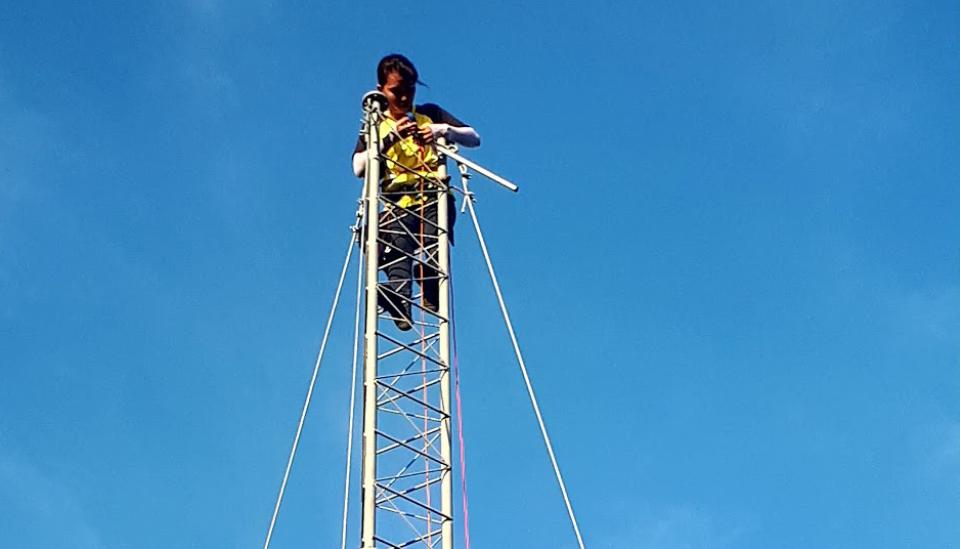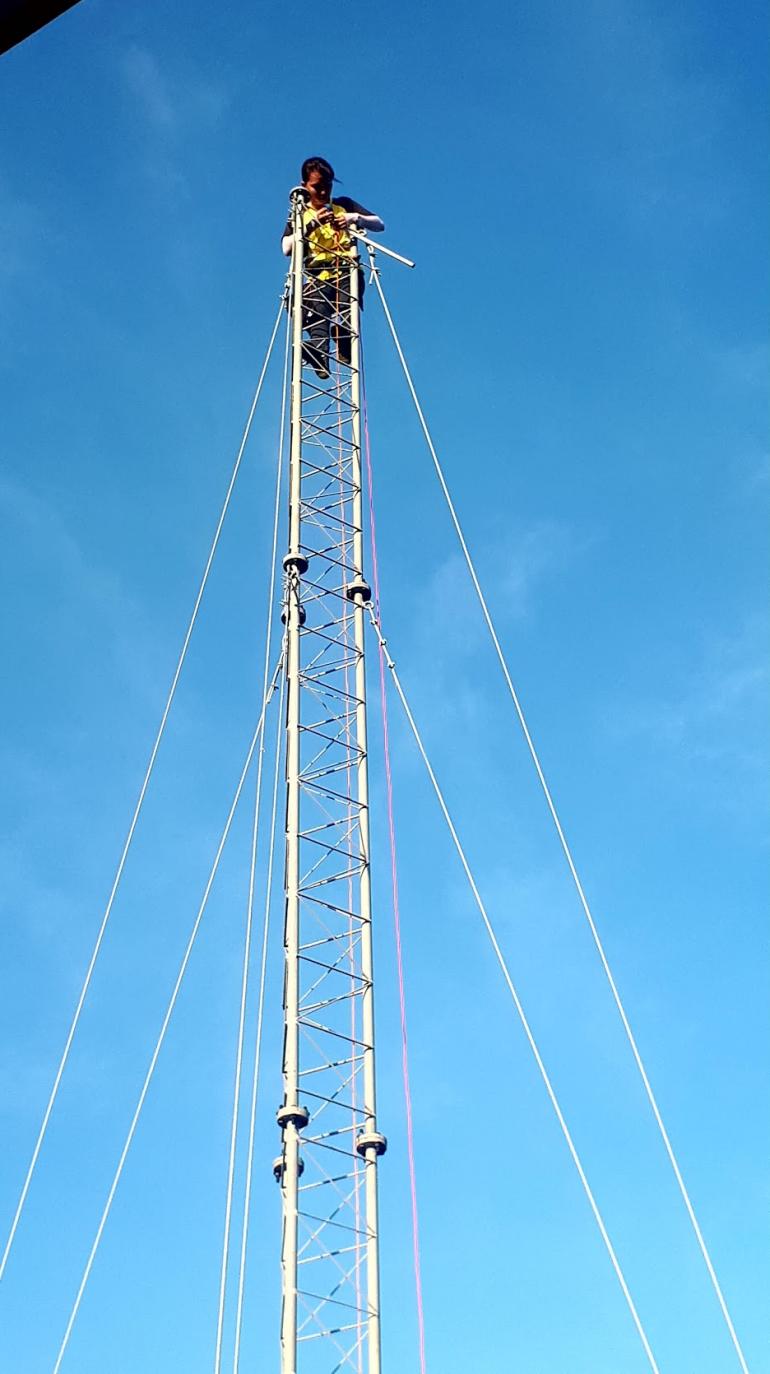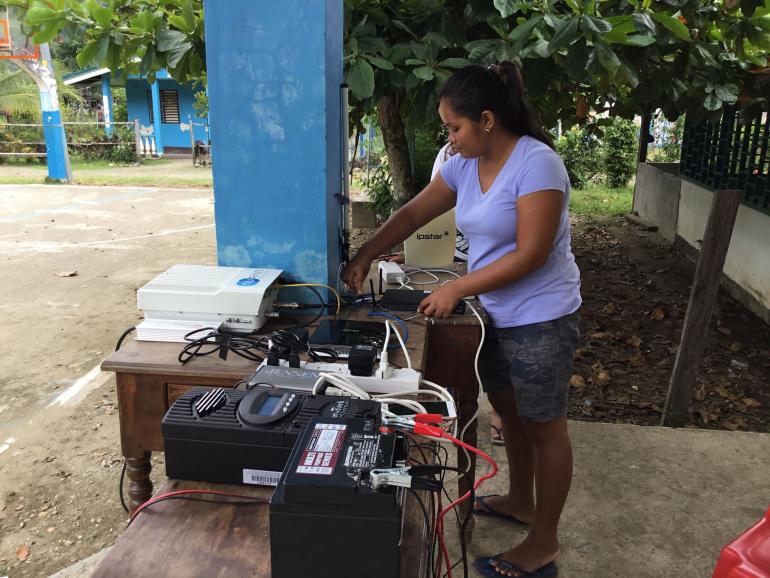
Image description: A person high up on a communications tower. Image source: Village Base Station Project, University of the Philippines.
As corporations and country leaders are propelling the world towards a digital society and information age, a large population in the Philippines still do not have access to basic voice and SMS communication, let alone internet connectivity. With just under 70% mobile phone penetration, populations that are isolated geographically and relatively poor are often considered “commercially unviable” within a business and technology model that is fuelled by capitalism.
Seeing the need for an innovative solution, a group of engineers and sociologists from the University of the Philippines have jointly founded the Village Base Station Project. The project is a public-private spectrum licensing partnership between commercial telco company i.e. UP, Globe Telecom and the local communities. Through development and deployment of GSM community cellular networks in the rural Philippines, the project delivers basic mobile telephony at a fraction of the capital and operational expenses of commercial cellular networks.
Through development and deployment of GSM community cellular networks in the rural Philippines, the project delivers basic mobile telephony at a fraction of the capital and operational expenses of commercial cellular networks.
In this interview, Serene Lim spoke with Mary Claire Barela, Thessa Cunanan and Clarisse Aquino from the University of the Philippines. Claire is the lead of the engineering team on the technical implementation of the project, including the development of software in the base stations that support localised pricing. She is also involved in engagement with various project stakeholders, among others, telco providers, research collaborators/partners. Thessa is responsible for the training of the local communities where she develops the training contents and conducts training through the implementation of the community network. She is also an antenna engineer and the main resource person for antenna-related requirements of the project. Clarisse is a research assistant for the qualitative research led by the Department of Sociology. She is also a key team member during site launches and community engagements.
In this conversation, we look at some of the observations and insights the team has on the social impact of the community networks to the barangay1 communities through a gendered lens.
Serene: Central to the idea of a community network is to bring connectivity to rural areas where incumbent operators have not or will not provide connectivity. Can you tell us more about the project you are undertaking and how does it fill in the gaps?
Claire: Our project aims to provide mobile telephony or connectivity such as basic voice and SMS to remote and rural areas of the Philippines where the incumbent operators will not deploy their services to. We do this by deploying community cellular networks using a small-scale, 2G-base station that provides basic voice and SMS services. Most people are already talking about internet access but we are addressing a fundamental and elementary need of these communities. These communities are isolated because of their geographical nature, there is no direct road access and they are isolated by part of the Sierra Madre Mountain Ranges that separate them from the main population.
In fact, when we first visited these sites, we were surprised that despite having no coverage, a lot of the locals already own cellphone devices. Whenever they are in the barangay community, rather than for communications, they primarily use the devices for entertainment purposes such as video, music, camera and photo. Prior to this project, they would have to travel to the provincial or to the municipal town centre to contact someone else.
In fact, when we first visited these sites, we were surprised that despite having no coverage, a lot of the locals already own cellphone devices.
Serene: Men and women are both involved in the community network. What have you observed in terms of women’s participation and can you explain their roles in this?
Claire: We have observed some ascribed gender roles for women when we were on sites. Thessa and I are engineers so we would climb towers and do things. When the local saw us climbing the towers, they would ask, “Why? You should ask the men to do it” and made comments that this was a man’s job. Some of them were impressed that we were not afraid of heights. I guess this is something that is still ingrained in the rural Philippines.
Thessa: We also conduct training to transfer knowledge and skill to the community, both on the technical and the business side of the project. When we asked for representatives from the community to do the maintenance tasks for the technical aspect, they would recommend the men; and likewise recommended the women as store owners or distributors.
When we asked for representatives from the community to do the maintenance tasks for the technical aspect, they would recommend the men; and likewise recommended the women as store owners or distributors.
Clarisse: I think it is important to locate the assignment of the gender roles within their context which are of fishing and farming community. The men are usually the heads of the household and they do fishing or farming in the mountain, or they work in the town to provide for their families. The women are the homemakers, they stay at home to take care of their children, or run a small convenience store for additional income for the family. Because the women are usually at home or in the barangay, they are the ones who usually join our training or orientation for the community network. Naturally, they become the ambassadors for the network! They would teach other people, like their husbands, daughters, sons or other people about the community network.
Because the women are usually at home or in the barangay, they are the ones who usually join our training or orientation for the community network. Naturally, they become the ambassadors for the network!
Women would also congregate as a group when they don’t have much to do after completing their chores in the afternoon. Our interviews with them suggest that it was during these congregations that they learnt from one another how to text and how to navigate their phone through storytelling.

Image description: A person high up on a communicatiaons tower. Image source: Village Base Station Project, University of Philippines
Serene: The idea of a community network can be alien and novel to some people simply because we are so accustomed to the current telco business model. Further, the design of technology and internet can be exclusive in which they often assume their users are of certain identities i.e. English-educated, bodily able, male-centric and heterosexual, located in the urban areas with good internet connectivity. So when the idea of community network was introduced to the locals, how was it received? And if there is any difference in responses by different group of people?
Clarisse: They were excited to finally have cellular signal and to have access to communications. But at the same time, they were of course concerns about their safety and the sensitive information that they may leak from these communications, especially for indigenous people living in one of the barangay. There were also concerns about potential addiction to the use of cellular phone and other bad habits they may develop. For example, they were concerns that the youth will resort to stealing of crops or other things to gather the resources to buy a new cellular phone.
There were also concerns about potential addiction to the use of cellular phone and other bad habits they may develop.
Claire: At this stage, we notice little disparity in the ways both men and women respond to the community network. Most of them appreciate the benefit of having cellular coverage. Women in the barangay area we work with are mostly decision-makers in their households. They manage the finances in the household and have a large say in the decision-making. In a way, women are not afraid to work with new technology. The preliminary analysis from our call data record indicates that the women, taking into account intersecting identities of age and economic status, are more likely to use what is provided by the community network than men.
The preliminary analysis from our call data record indicates that the women, taking into account intersecting identities of age and economic status, are more likely to use what is provided by the community network than men.
We think this is because the men in the household are mostly away for work i.e. in the open sea and at the top of the mountains and they leave their cell phones in the houses or in the custody of their wives. In fact, we observe more disparity in terms of usage of the network between the youth and the elderly. We will have a better picture of the various identity-based dynamics in place, including gender, once we have completed the research.
Serene: What are some of your observations on the social impact or the role of the community networks in their everyday lives so far?
Claire: We are still in midst of evaluating the impact in terms of economic livelihood, expansion of social networks and other things. But I would say from our initial observations, we can see that the ability to stay “connected” is something very valuable. For example, being able to call friends and family from the barangay, especially for mothers with children in a different town. In addition, the community network also enables access to information (market price for goods, information about the typhoon and other disasters) which then leads to an informed decision-making process. We also observe that there is improved local governance where coordination between the barangay and the municipal town has been made easier such as requests for assistance or aid, dissemination of warnings and the submission of reports.
Serene: What do you think can be done to encourage more women to take up the technical side and for a more equal distribution of roles, knowledge and skills?
Thessa: We have observed that both men and women can do the same job. In a workshop designed to evaluate a repair tool that our team had developed, we staged different scenarios for the participants to solve individually, such as overheating of computer etc. We have observed how both men and women were able to solve the problem when guided by our repair tool. It is clear that if women are trained as much as men, they too can manage the technical side of the community network.
Claire: I guess in terms of capability, women in the areas we work with are capable and they do have the technical capacity. For example, they know how a solar panel works and they have the basic knowledge on how electricity is stored in the battery. I think what is required is a local role model. I can observe that they can do it, they are not putting themselves forward because of the expectation that these are men’s jobs. Of course, we are also women in the project team and we can do technical stuff and (in a way) we are a role model, but we are not the locals. I am thinking that there should be a local representative to do the job.
What is required is a local role model.

Image description: A woman setting up network cables on a table. Image source: Village Base Station Project, University of Philippines
1 The smallest administrative division in the Philippines and is the native Filipino term for a village.
- 10852 views






Add new comment